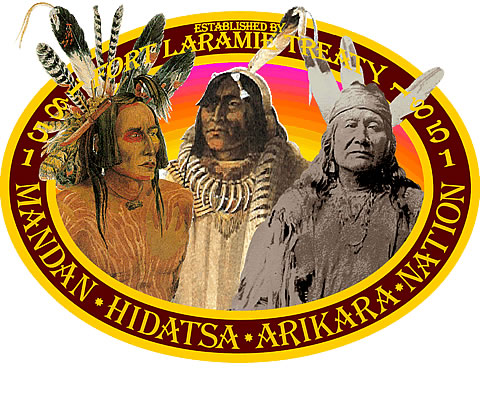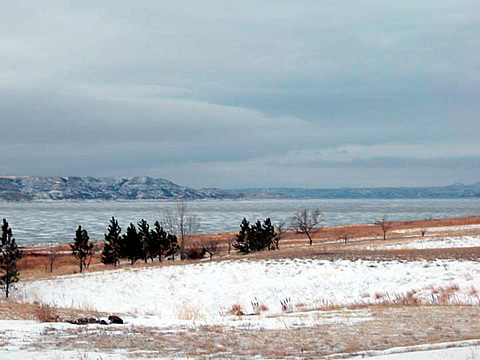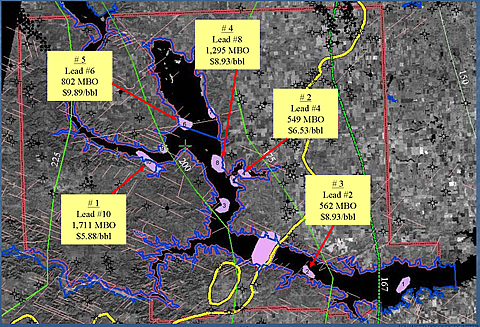The Three Affiliated Tribes-Mandan, Hidatsa and Arikara-have almost 600,000 acres of land in the Fort Berthold Reservation in North Dakota open for oil and gas exploration. The reservation lies close to the Nesson Anticline, a large oil producing structure in the southern Williston Basin. Approximately 40 MMbbl of oil have been identified on Tribal lands in Antelope Field.
150,000 acres of Tribal lands lie beneath Lake Sakakawea, formed when the Army Corps of Engineers built a dam on the Missouri River in 1951. In the past ten years the lake and mineral rights under the lake were restored to Tribal ownership. Although 100 wells have been drilled on tribal lands, no wells have been drilled on Lake Sakakawea acreage, due to lack of knowledge about potential structures or delineation of prospects.
Project Results
Eleven oil prospects under Lake Sakakawea have been identified using remote sensing technologies.
Benefits
The oil recovered from the Fort Berthold region will be a significant benefit to the Three Affiliated Tribes. If all are successful, the eleven leads identified are estimated to yield a total of 8.9 MMbbl of recoverable oil.
The integrated approach to surveying a large block of undeveloped land provides a method that other Tribes in the western U.S. may find useful for exploration of land that has only recently been turned over to them through Federal and State policies. The technologies for exploration and assessment of oil potential under bodies of water or areas where surface access is restricted by other factors provides opportunity for development using innovative horizontal drilling and completion methods.
Project Summary
- Two LandSat images acquired to provide coverage beyond bounds of reservation area, and to assist in fault interpretation.
- Lineament density maps constructed from multiple fracture orientations. The lineaments represent the surface traces of fracture zones that create linear trends of weak, easily eroded rock.
- Northeastern portion of reservation heavily glaciated reducing the number of lineaments observed.
- Lineaments were traced into and calculated below the glacial till.
- Reviewed and mapped the regional scale national isostatic and aeromagnetic grids and integrated the data to local scale.
- Remote sensing and regional gravity and magnetic data sets support four additional basement shear zones in addition to three previously identified zones.
- 200 miles of seismic survey data was purchased and interpreted.
- Seismic data provided direct indications of structure and potential leads under Lake Sakakawea.
- Primary hydrocarbon targets in the area east of Antelope tend to be combined structural/stratigraphic traps formed on and around subtle paleohighs.
Completed the analysis of all producing wells in or near the Fort Berthold reservation to compare and contrast potential for leads under Lake Sakakawea.
ARI developed an exploration strategy for Fort Berthold using 200 miles of seismic, Landsat and aeromagnetic data covering the area surrounding and beneath Lake Sakakawea. Geological analysis began with studies of surface lineaments using satellite imagery and high-resolution aeromagnetic data. Existing onshore data was reprocessed using improved methodology, and integrated with 200 miles of new seismic survey data. Well data from existing wells in Antelope Field producing from Madison Limestone and Bakken Shale provided data for geologic correlation, information on drilling and completion intervals, and estimates of well rates and recovery factors. Because the area of interest was under Lake Sakakawea, the use of onshore horizontal wells (to extend under the lake) were studied.
Seismic data and aeromagnetic depth maps were combined to image paleohighs revealing numerous seismic structures in the western portion of the Fort Berthold Reservation, including four previously unidentified basement shear zones. The structures are larger than typical Williston Basin Red River structures. Oil in Antelope Field accumulated in structural and stratigraphic traps in and around paleohighs. Ten promising structural prospects were generated by the combined seismic, aeromagnetic and Landsat surveys. These areas are all assessable using horizontal well technology. Oil potential was also identified based on stratigraphic mapping in the eastern portion of Lake Sakakawea. The 11 identified prospects may expect oil recovery ranging from 283,000 to 1.7 MMbbl each.
Horizontal wells in the southern Williston Basin cost $450,000 to $1 million, thus using all available data and resources to generate and analyze prospects is an important strategy.







